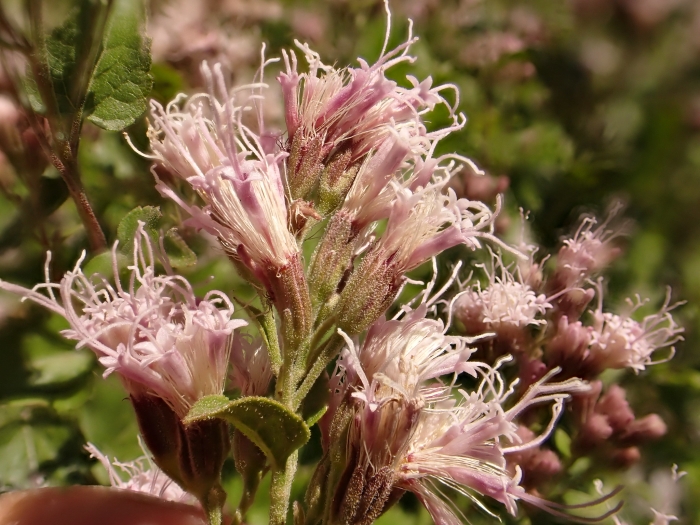Western Snakeroot
(Ageratina occidentalis)
Western Snakeroot (Ageratina occidentalis)
/
/

Matt Lavin
CC BY-SA 2.0
Image By:
Matt Lavin
Recorded By:
Copyright:
CC BY-SA 2.0
Copyright Notice:
Photo by: Matt Lavin | License Type: CC BY-SA 2.0 | License URL: https://creativecommons.org/licenses/by-sa/2.0/ | Uploader: Matt Lavin | Publisher: Flickr |































Estimated Native Range
Summary
Ageratina occidentalis, commonly known as Western Snakeroot, is a deciduous perennial herb or subshrub native to mountainous regions, forest clearings, and streambanks in the Western United States. It typically grows to a height of approximately 70 centimeters with fuzzy green or purple stems. The leaves are distinctive for their glandular texture and triangular shape with serrated edges. From late summer to fall, it produces a dense cluster of fuzzy flower heads with long, protruding disc florets in shades of white, pink, and blue, although the flowers are not particularly showy. The fruit is an achene with a rough, bristly pappus that aids in wind dispersal.
Western Snakeroot is valued for its adaptability to a range of soil conditions and its ability to thrive in both full sun and partial shade. It is often used in native plant gardens, restoration projects, and as a component of pollinator-friendly landscapes. While it is not known for aggressive growth, it can spread through rhizomes and self-seeding, which should be considered in garden planning. It is relatively low-maintenance, requiring medium amounts of water and tolerating various drainage speeds. There are no significant disease issues, but it can occasionally suffer from rust or mildew in overly moist conditions.CC BY-SA 4.0
Western Snakeroot is valued for its adaptability to a range of soil conditions and its ability to thrive in both full sun and partial shade. It is often used in native plant gardens, restoration projects, and as a component of pollinator-friendly landscapes. While it is not known for aggressive growth, it can spread through rhizomes and self-seeding, which should be considered in garden planning. It is relatively low-maintenance, requiring medium amounts of water and tolerating various drainage speeds. There are no significant disease issues, but it can occasionally suffer from rust or mildew in overly moist conditions.CC BY-SA 4.0
Plant Description
- Plant Type: Herb, Subshrub
- Height: 0.5-2 feet
- Width: 2-3 feet
- Growth Rate: Moderate
- Flower Color: White, Pink
- Flowering Season: Summer
- Leaf Retention: Deciduous
Growth Requirements
- Sun: Full Sun, Part Shade
- Water: Medium
- Drainage: Slow, Medium, Fast
Common Uses
Bee Garden, Bird Garden, Low Maintenance, Rock Garden, Showy Flowers
Natural Habitat
Mountainous regions, forest clearings, and streambanks in the Western United States
Other Names
Common Names: Western Eupatorium, Western Joepyeweed
Scientific Names: , Ageratina occidentalis, Eupatorium occidentale, Eupatorium occidentale var. decemplex, Eupatorium occidentale var. subroseum, Eupatorium oregonum, Eupatorium occidentale var. occidentale, Kyrstenia occidentalis,
GBIF Accepted Name: Ageratina occidentalis (Hook.) R.King & H.Rob.